Bronze Alloys
Of all the bronze and brass materials available, bronze alloys come in various shapes and are generally available in sheet/plate, rods, tubes, or bar stock products. Bronze alloys are also known for their strength and ductility and are corrosion-resistant in many circumstances. Bronze is typically harder than copper. It is the result of adding other metals like tin.
Bronze alloys are the most consist of pure copper and zinc, and some are an alloy of copper and tin, and other elements. They are typically a bronze alloy consisting of copper in the range from 58 to 98%, and almost all have at least small amounts of zinc, from .2% to 40%. Wrought bronze is typically known as the following alloys:
They are typically produced by rolling and extrusion mills or by a forging mill. In either case, the material starts out as a particular shape (i.e., round or square block or billet) and is then cast into the desired form by either "extruding or pushing" the material or by "hammering or forging" the material down into shape. Additionally, some of our material is available in an "as cast and cold drawn condition". This process involves casting the rod and then repeatedly cold drawing it to its final dimension and annealing it during the process when necessary.
Hot Extrusion
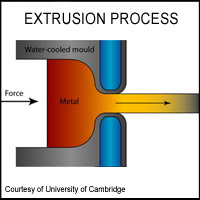 In bronze extrusion, a bronze bar or sheet is forced from an enclosed cavity via a die orifice by a compressive force applied by a ram. Since there are no tensile forces, high deformations are possible without the risk of fracture of the extruded material. In bronze extrusion, a bronze bar or sheet is forced from an enclosed cavity via a die orifice by a compressive force applied by a ram. Since there are no tensile forces, high deformations are possible without the risk of fracture of the extruded material.
The extruded article has a reduced cross-sectional area and a good surface finish, so further machining is unnecessary. Extrusion products include rods and tubes with varying degrees of cross-section complexity.
The bronze alloy extrusion process allows for the production of solids, tubes, and profiles. Contact one of our sales representatives to find out if your application, spec, and material require an extruded product.
PICTURE COURTESY OF: https://www.doitpoms.ac.uk
Bronze Forging
There are 2 main types of bronze alloy forging methods: Closed Die Forgings and Open Die Forgings.
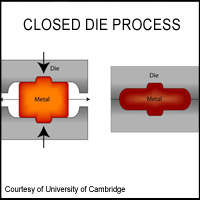
In Closed-Die Forgings, a single piece of metal, normally hot, is deformed mechanically by successive blows or continuous squeezing. A force is applied to a metal slug or preform placed between two (or more) die halves. The metal flows plastically into the cavity formed by the die and hence changes shape to its finished shape.
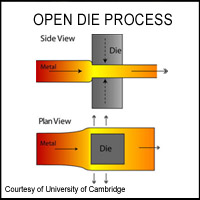
In Open Die Forgings, the metal is between flat dies with no pre-cut profiles. The dies do not confine the metal laterally during forging.
Deformation is achieved through movement of the workpiece relative to the dies.
Cold Drawn
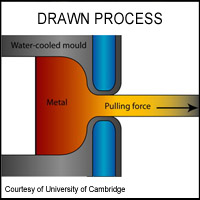 Drawing is the pulling of a metal piece through a die by means of a tensile force applied to the exit side. A reduction in cross-sectional area results, with a corresponding increase in length. A complete drawing apparatus may include up to twelve dies in a series sequence, each with a smaller hole than the preceding one. Drawing is the pulling of a metal piece through a die by means of a tensile force applied to the exit side. A reduction in cross-sectional area results, with a corresponding increase in length. A complete drawing apparatus may include up to twelve dies in a series sequence, each with a smaller hole than the preceding one.
Cold Drawing bronze alloys involves casting a rod (solid shape) or profile first, and then, after a careful pre-treatment procedure and de-scaling of the bar, drawing it through a forming die. This operation is typically repeated several times.
Metals can be formed to much closer dimensions by drawing than by rolling. Drawn products include wires, rods, and tubing. When thin walls and very accurate finishes are required, seamless tubing can be produced by cold drawing. This process tightens the cross-sectional tolerances, improving dimensional accuracy and surface quality.
Cold drawn material offers extensive advantages, among other things:
- Smooth and scale-free surface
- Sharp edges
- Uninterrupted grain orientation
- Increased tensile strength and yield point
Atlas Bronze offers several cast and drawn bronze alloys. Contact one of our sales representatives to find out if your application, spec, and material require a cast and drawn product.
Hot Rolling
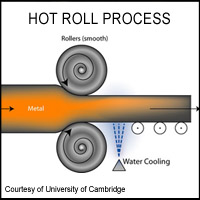 Rolling is the most widely used bronze alloy deformation process. It consists of passing metal between two rollers, which exert compressive stresses,
reducing the metal thickness. Where simple shapes are to be made in large quantities, rolling is the most economical process. Rolled products include sheets, structural shapes, and rails, as well as intermediate shapes for wire drawing or forging. Circular shapes, ‘I’ beams, and railway tracks are manufactured using grooved rolls. Rolling is the most widely used bronze alloy deformation process. It consists of passing metal between two rollers, which exert compressive stresses,
reducing the metal thickness. Where simple shapes are to be made in large quantities, rolling is the most economical process. Rolled products include sheets, structural shapes, and rails, as well as intermediate shapes for wire drawing or forging. Circular shapes, ‘I’ beams, and railway tracks are manufactured using grooved rolls.
Hot rolling achieves the initial breakdown of an ingot or a continuously cast slab. Mechanical strength is improved, and porosity is reduced. The worked metal tends to oxidize, leading to scaling, which results in a poor surface finish and loss of precise dimensions. A hot-rolled product is often pickled to remove scale and further rolled cold to ensure a good surface finish and optimize the mechanical properties for a given application.
Atlas Bronze offers several wrought bronze alloys hot rolled.
Contact one of our sales representatives and find out if your application, spec, and material require a hot rolled product.
PICTURE COURTESY OF:
https://www.doitpoms.ac.uk
Some of today's modern bronze are coming in the form of wrought bronze products. This typically allows the mechanical properties to be more uniform in the metal.
Please ask or email one of our sales representatives to find out how we can help you.
|





 In bronze extrusion, a bronze bar or sheet is forced from an enclosed cavity via a die orifice by a compressive force applied by a ram. Since there are no tensile forces, high deformations are possible without the risk of fracture of the extruded material.
In bronze extrusion, a bronze bar or sheet is forced from an enclosed cavity via a die orifice by a compressive force applied by a ram. Since there are no tensile forces, high deformations are possible without the risk of fracture of the extruded material.


 Drawing is the pulling of a metal piece through a die by means of a tensile force applied to the exit side. A reduction in cross-sectional area results, with a corresponding increase in length. A complete drawing apparatus may include up to twelve dies in a series sequence, each with a smaller hole than the preceding one.
Drawing is the pulling of a metal piece through a die by means of a tensile force applied to the exit side. A reduction in cross-sectional area results, with a corresponding increase in length. A complete drawing apparatus may include up to twelve dies in a series sequence, each with a smaller hole than the preceding one.
 Rolling is the most widely used bronze alloy deformation process. It consists of passing metal between two rollers, which exert compressive stresses,
reducing the metal thickness. Where simple shapes are to be made in large quantities, rolling is the most economical process. Rolled products include sheets, structural shapes, and rails, as well as intermediate shapes for wire drawing or forging. Circular shapes, ‘I’ beams, and railway tracks are manufactured using grooved rolls.
Rolling is the most widely used bronze alloy deformation process. It consists of passing metal between two rollers, which exert compressive stresses,
reducing the metal thickness. Where simple shapes are to be made in large quantities, rolling is the most economical process. Rolled products include sheets, structural shapes, and rails, as well as intermediate shapes for wire drawing or forging. Circular shapes, ‘I’ beams, and railway tracks are manufactured using grooved rolls.













